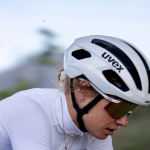Lululemon Athletica CEO Christine Days announcement that she will step down as CEO as soon as her board can find her successor prompted a selloff of the companys stock last week that did far more damage than the companys March recall of its iconic black yoga pants.
Even after the decline, which knocked more than $2 billion off the companys market value, the value of a share of LULUs stock has nearly tripled since the Day took over as CEO. Sales grew nearly five-fold to $1.37 billion during the first five years of her tenure from 2008 through 2012. Sales per square foot grew 21 percent to $2,058 at stores open at least a year during that period, even as the company more than doubled its store count to 211 and greatly expanded its e-commerce operation.
Finally, Day appears to have helped transform what was once a womens yoga apparel brand into a performance apparel line that is increasingly selling to men, runners and cyclists.
Being a part of Lululemon for the past five and a half years has been an incredible journey, she told analysts at the beginning of the companys regular first-quarter conference call last week. I am proud of building a world-class team that has produced one of the best growth, brand and profit stories in retail. Plans have been laid for the next five years and a vision set for the next ten. Now is the right time to bring in a CEO who will drive the next phase of Lululemons development and growth.
Day will continue to actively lead the company until its board can hire her replacement, but said she will not remain on the board after stepping down.
Even after taking a $17.5 million charge for costs associated with the recall of its iconic luon yoga pants, LULU reported net revenue rose 21 percent to $345.8 in the first quarter ended May 5, compared with $285.7 million in the second quarter ended April 29, 2012. Comp store sales rose 7 percent on a currency neutral basis, which was on the upper end of guidance. Direct-to-consumer revenue increased 40 percent to $54.0 million, or 15.6 percent of total company revenues, up 210 basis points from the first quarter of fiscal 2012.
Gross profit increased 9 percent to $170.7 million, or 49.4 percent of revenue, down 460 bps from the year earlier quarter.
SG&A crept up 90 bps to 30.3 percent of revenues, resulting in a 10 percent decline in income from operations and a 650 bps plunge in operating margins, which fell to 19.1 percent. Diluted earnings per share were 32 cents on net income of $47.3 million, which was flat with a year earlier, but above the 28 cents to 30 cents a share range the company forecast in mid-March, when it disclosed it was recalling its luon pants because of a flaw in the fabric that rendered them see-through during stretching exercises common to yoga and other workouts.
The recall took the companys best-selling product out of stores for 90 days, cost the companys top product executive her job, slowed sales of color tops in the key spring season and renewed speculation that the company had outgrown its infrastructure and management. Lululemon CFO John Currie said being able to get luon pants back on shelves in early June will likely enable the company to recover $15 million of the $67 million shortfall originally forecast. The company plans a hard launch of the pants once stores are fully restocked, which will likely be in mid-July.
I think there is quite a few things that we learned in this whole process, Day said. And I think number one was if there were 10 technical specs, we were probably controlling four. So we had to become our own expert in depth in all of the technical specs, not just relying on our factory partners for some of them. We also, as we grew, had not managed grading, for instance, at every single factory from one master pattern. And with our tolerances, as we really dug deep and did a lot of investigation, found that a size 2 sewn to the large end of the tolerance in one factory was too close to a 4 sewn to the small tolerance in another factory. So we brought in a master pattern grader, and every single factory has all the same patterns now. We also reduced our tolerances from an inch to half an inch, which takes more to sew.
Day emphasized that despite the recall, LULU made significant progress during the quarter with its international expansion, including opening of showrooms in London, Berlin, and Singapore and an online store in New Zealand. It also secured permits needed to begin opening stores in Hong Kong and Shanghai.
Back in North America, the company began beefing up testing and quality-assurance protocols, raw material teams, increased factory oversight and training and education. It has lined up candidates for the new positions of SVP of logistics and an EVP of design and merchandising.
On the product side, LULU received positive feedback on new tennis, golf, swim and cycling collections and has seen particularly strong sales of its Mens apparel. Day said the company will likely open its first stand-alone Mens shops by 2016. That initiative is being led by Felix Del Toro, a former Gap and Warnaco executive who LULU hired in April as SVP and GM for mens.
While we regret that we had a quality issue with our black luon, we are proud of the organization’s ability to get Luon delivered back into our stores within 90 days of having pulled it from our line, all the while keeping our guests happy and engaged with the brand, said Day. There is across-the-board excitement about being back in black. Our stores are back to being their cheeky, fun and irreverent selves.
LULU expects diluted earnings per share of 33 to 35 cents in the second quarter, when comparable store sales are forecast to grow in the 5 to 7 percent range. Currie said the company will have to spend more on air freight to ensure timely fall deliveries, which have been disrupted as the company scrambled to backfill its shelves in the wake of the luon recall.















